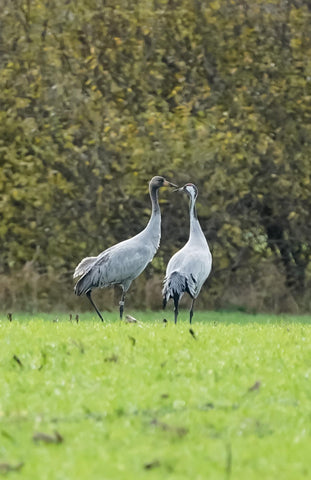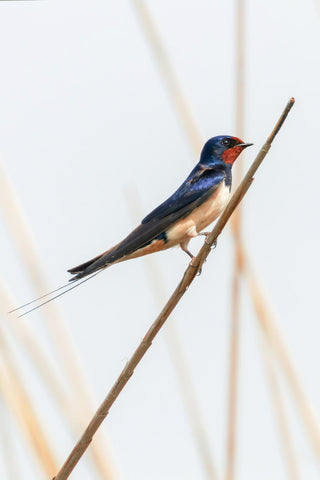Spring is the time when nature comes to life and you can observe birds returning to Poland after their winter break. Bird migration is an extraordinary phenomenon that heralds the change of seasons each year and at the same time highlights the richness of our native avifauna. We will look at birds symbolizing the arrival of spring in Poland, as well as birds that spend the winter abroad and now systematically return to our area.
Birds Symbolizing the Coming of Spring
 Both larks and cranes are often considered to be the first birds to return to Poland, heralding the beginning of spring . Already at the end of February, you can hear the characteristic, melodic song of the skylarks , which resounds around, adding magic and excitement that spring is coming.
Both larks and cranes are often considered to be the first birds to return to Poland, heralding the beginning of spring . Already at the end of February, you can hear the characteristic, melodic song of the skylarks , which resounds around, adding magic and excitement that spring is coming.
The lapwing is another early spring newcomer, with black and white coloring and a small crest, it is a protected species, although unfortunately its population is decreasing. If you encounter a lapwing during your observations, it is a sign that nature is slowly waking up to a new cycle of life.
The crane , known for its loud, distinctive cawing, inhabits swampy areas. It is one of the largest birds in Poland, which makes it impossible to miss during observation.
With the first appearance of early spring flowers, such as snowdrops and crocuses, nature gradually begins to display its colorful blanket. In the forests or adjacent meadows you may come across hepatica or anemones as heralds of the new season.
Swallows usually appear in Poland around mid-April, and their agile silhouettes in the sky are a sure sign that warmer days are inevitable.
Storks , beloved Polish spring birds, are a symbolic sign that spring is near.
In addition to birds, other signs of spring include the awakening of common frogs from hibernation, the appearance of insects such as ladybugs, wingless nuthatches and some species of butterflies, and the gradual awakening from hibernation of dormice and hedgehogs.
To notice the arrival of spring , it is best to go for a walk and carefully observe the surroundings. Your senses will quickly notice changes when birds that spend the winter abroad return to their home range.
Bird Species Returning in March and April
![]() As spring progresses, you can observe birds returning to Poland in spring after their winter break. These extraordinary winged returns are a sign that nature has fully awakened.
As spring progresses, you can observe birds returning to Poland in spring after their winter break. These extraordinary winged returns are a sign that nature has fully awakened.
White storks are among the first to cross the borders of our country. They start their journey from Africa at the end of February or at the beginning of March and for many Poles they are the epitome of the coming spring .
You will certainly notice the flocking returns of various geese that fill our sky with their characteristic "honking". They appear in Poland already in March, and their arrival is an announcement of the upcoming spring weather.
Perhaps less desirable due to their conservative nature, cuckoos, known for their brood parasitism, also return to Poland around April.
On April and May days, you can enrich your observations with:
- After a winter break in Africa, where they rest and breed, swallows have been decorating the Polish sky with their agile flights since mid-April.
- At the end of April or the beginning of May, the swifts return, flying across the Polish sky, spending most of their lives in the air, tirelessly cutting through the air.
- After spending the winter in warmer parts of Europe, the Middle East or Asia, larks return to our country in April or May. Their singing is one of the most beautiful melodies of a spring morning.
- In April and May , nightingales decorate the Polish landscape, and their enchanting songs fill the night, a true harbinger of spring splendor.
- Starlings can return early, sometimes as early as late February or early March, delighting many people with their vocal imitations of other animals and even human speech.
- Cranes are considered one of the first heralds of the arrival of spring, their characteristic calls can be heard in the fields when they reach Poland in late February or early March.
It is very important to realize that many of these bird species are facing population decline due to habitat loss, pollution and other human activities. Therefore, it is worth considering how we can contribute to the protection of these irreplaceable inhabitants of our flora and fauna, so that future generations can also enjoy the birds returning in spring .
How to care for birds after returning from migration?
After spring migration, birds need proper care to ensure their survival and successful reproduction. Specially prepared birdhouses in your garden may be helpful in this regard, as they provide protection against bad weather conditions and predators. Here are some tips on how you can take care of birds returning to Poland in spring :
- Installing birdhouses: Placing birdhouses in your garden will allow you to closely observe the unique behavior and plumage of birds and provide them with a safe haven during migration. Additionally, you will contribute to maintaining ecological balance by controlling pest populations and the health of your plants.
- Create a natural pest control system: By inviting a variety of bird species into your garden, you create a natural pest control system, which reduces the need for artificial chemicals. By supporting bird populations through nesting boxes and feeding, you also help maintain biodiversity and ecosystem health.
Remember that birds play an important role in the ecosystem - apart from consuming insects and pests, they also contribute to pollinating plants and dispersing seeds. Additionally, World Migratory Bird Day is celebrated annually on the second weekend of May to promote the conservation of migratory birds. These extraordinary creatures face numerous threats, including habitat loss, climate change and hunting, and an estimated 250 million birds die during migration each year in the Mediterranean region. Therefore, protecting their habitats, especially during migration, is crucial for their survival.
Bird Observations – Where, when and how is the best way to observe them?
 To enjoy watching birds returning to Poland in spring, go outside in the first hours after sunrise or around sunset - this is the time when birds are most active. To experience this exciting activity, find a place that is rich in natural bird habitat, such as rural areas, banks of rivers, lakes, sea.
To enjoy watching birds returning to Poland in spring, go outside in the first hours after sunrise or around sunset - this is the time when birds are most active. To experience this exciting activity, find a place that is rich in natural bird habitat, such as rural areas, banks of rivers, lakes, sea.
Here are some points to pay attention to when preparing for your observation:
- Places and environments: Depending on what Polish spring birds you are most interested in, look for appropriate locations taking into account the birds' preferences for specific tree areas. Larger species prefer tree canopies, while smaller species can be found among branches and trunks. Some bird species, such as black storks, need trees with wide-spreading branches to build their nests, while large woodpeckers need thicker branches and slightly rotting wood to dig suitable nests.
- Observing rules: Silence and keeping a safe distance from birds is key to minimizing disturbances - remember that bird watching is a form of respectful appreciation of nature.
- Prepare the necessary accessories: good quality binoculars or a telescope, an ornithological guide, appropriate clothing, comfortable footwear, and food and drink.
- Technology and collaboration: Use bird identification apps that recognize species based on their songs or appearance. Such tools make it much easier to recognize birds that spend the winter abroad and come to Poland in spring.
Popular locations for bird watching in Poland include the Barycz Valley, Podlasie, Karsiborska Kępa, Poleski National Park, Słowiński National Park, Międzyrzecki Rejon Umociony, Warta Mouth National Park, Bieszczady Mountains and Milickie Ponds. In many of these places it is possible to organize birding tours and guides who will help you understand the behavior and potential habitats of birds returning in spring. It is worth remembering that although birdwatching in Poland is not as popular as in Great Britain or the USA, the country offers diverse ecosystems and many fantastic places for observation.
A fascinating journey through the world of winged wanderers
Birds returning to Poland in spring are the embodiment of the rebirth of nature and an integral element of our ecosystem, the value of which cannot be overestimated. By understanding their habits, importance in nature and needs after returning from migration, we can more effectively support their populations and contribute to the preservation of biodiversity. Also aware of the threats they face, such as habitat loss and climate change, we are faced with the important task of working to protect these beautiful wanderers.
It should be emphasized that the responsibility for bird protection rests with the community. Each of us can contribute to improving their living conditions - from setting up nesting boxes to sowing bird-friendly plants. Protecting birds is more than just admiring their beauty; is an active action that aims to secure the future not only of these winged inhabitants, but also of our common environment. Let inspiring bird watching contribute to deeper ecological awareness and increased commitment to supporting the natural environment.

